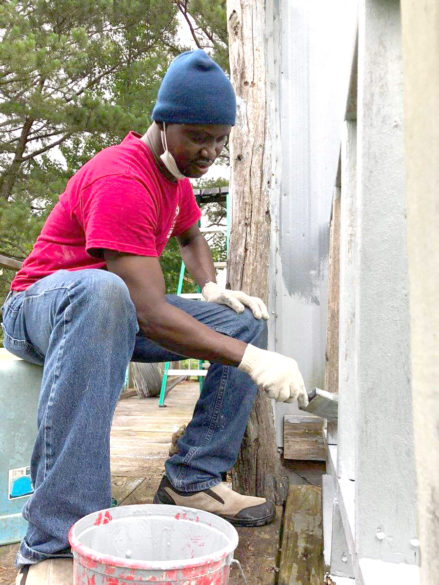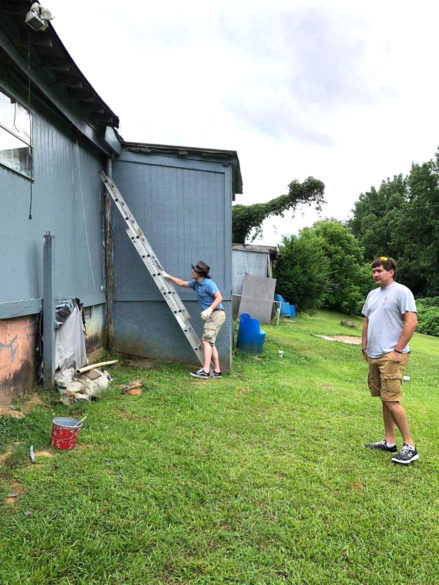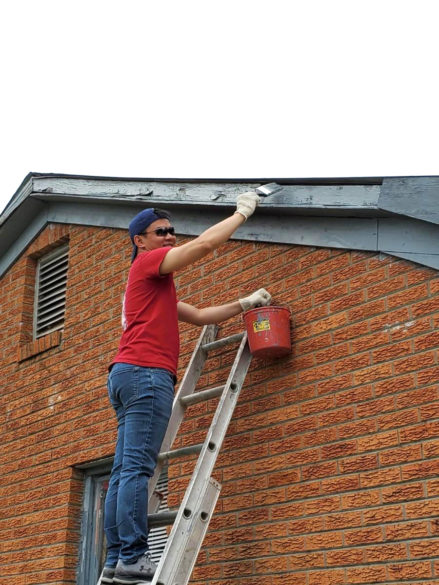By Laura Grisham
SOUTHAVEN – Sacred Heart students and Frater Hubert Liassidji, SCJ Jonathan Nguyen, Jacob Smith and Frater John Huan Nguyen, SCJ finished up a pre-COVID painting project this week. Volunteers began working on Edna’s home in Holly Springs earlier this year. The pandemic halted volunteer work mid-March. The elderly woman was extremely grateful to have this phase of the repairs complete.
Author Archives: Tereza Ma
Knights join together to work with Carmelites
By Joanna Puddister King and Tereza Ma
JACKSON – On a beautiful Saturday, May 30, Knights from various councils spent their morning in South Jackson at the Carmelite Monestery cutting grass and working on various projects for the cloisered community of nuns that pray for the Diocese of Jackson. But it doesn’t seem like work showing up every other Saturday to work on various projects, “it is very fulfilling,” says Calvin Torregano of St. Jude.
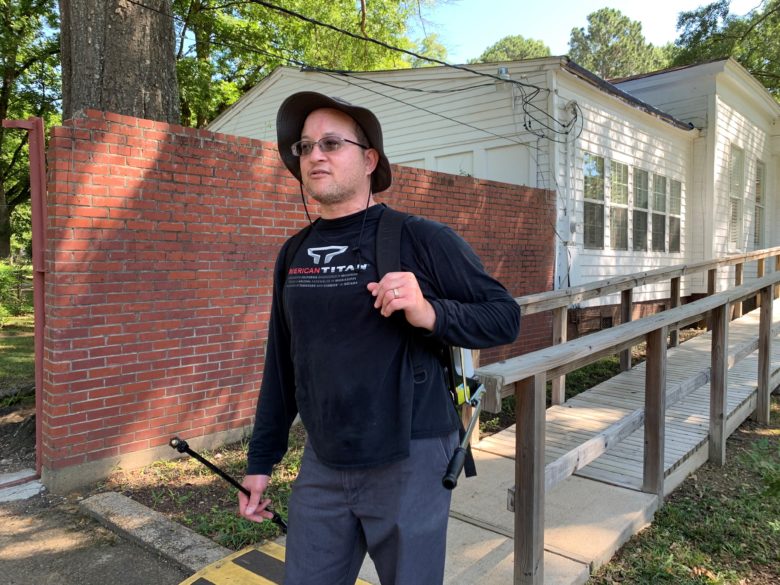
Torregano set up an app for Knights from various councils to coordinate who can help and when. It has helped the councils chip away at the various projects at the property, built in 1836.
It all began with Father Lincoln Dall about two years ago with a conversation after Mass, says Torregano. Father Lincoln mentioned how many projects needed to be tackled at the monastery and then the idea “blew up” at a Knights convention on the coast.
In the past, individual councils from Holy Savior Clinton, St. Paul Flowood, St. Jude Pearl, St. Joseph Gluckstadt and St. Richard Jackson have worked to replace windows, rebuild a gazebo, to build two handicap accessible ramps, to clean and rebuild a wall and much more. Even the Ladies Auxiliary of St. Joseph Gluckstadt has jumped in to help with various cleaning projects starting three years ago with pressure washing and work inside the Carmelite gift shop. This past year, even a group of seniors from St. Joseph school in Madison came out to help to clean up the grounds. “It is the perfect place for service hours,” says Torregano.
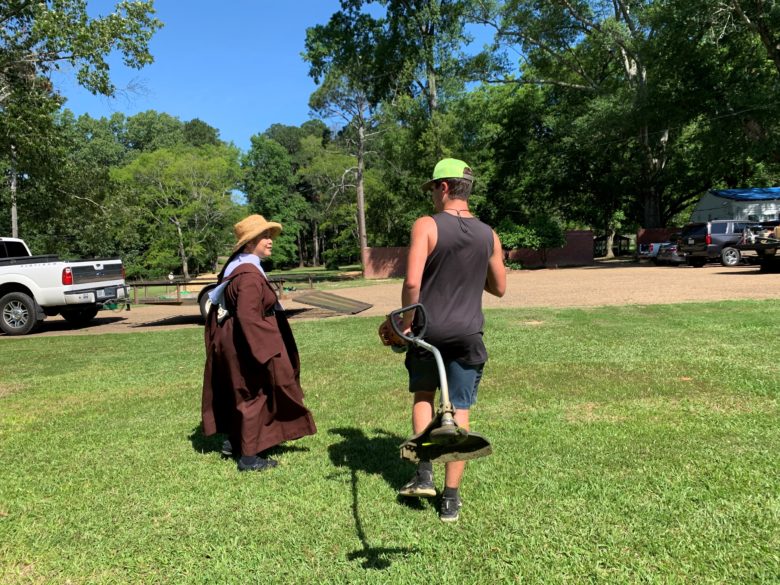
For large projects, Victor Gray-Lewis of the St. Richard group of Knights and the Diocese of Jackson helps make sure all of the details are covered for construction. The Knights aim to complete a few projects before the Solemnity of Our Lady of Mount Carmel on July 16. Torregano says they would like to finish spreading some dirt, get siding on the garage replaced and painted and a new roof on the gift shop, among others.
Meet Ryan Stoer
In preparation for our Homegrown Harvest Gala in the fall, which will benefit the Diocese of Jackson Office of Vocations, over the next several weeks we will feature a Q&A with one of our seminarians. This week, meet Ryan Stoer who is entering his fourth year of formation.
What is your home parish?
St. Richard, Jackson
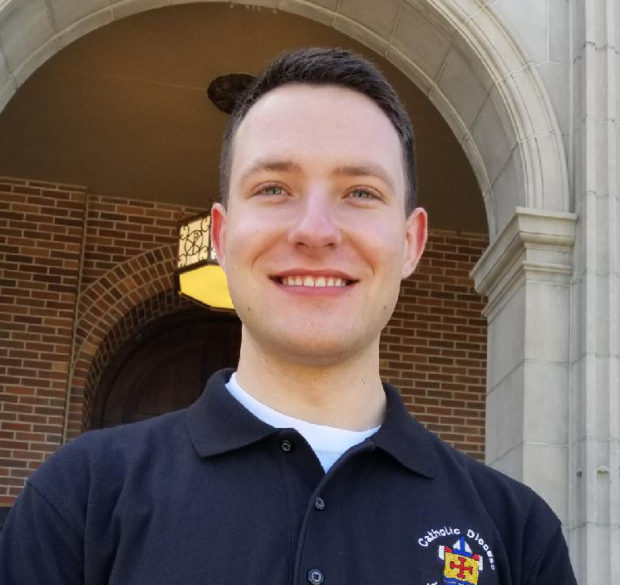
What is your background?
I was born In San Diego, and I have lived in Ohio and New Mexico. I graduated with a degree in Mechanical Engineering from New Mexico Tech. I had a few job offers after I graduated, but I ended up taking a job which required a security clearance. My parents had moved to Mississippi while I was in college, so I stayed with them as I waited for my clearance. During this time of waiting, I was told that I should consider the priesthood.
What is your vocation story? Who influenced you and why?
My vocation story is relatively simple. All it took was a single question. But, before I get to that question, I will give you a little of my background.
For much of my life, I considered success the highest goal. I did well at almost everything I tried. In high school I graduated as the salutatorian and I did well at swimming. I practiced and strived for perfection in academics, sports, and in everything where anyone had any expectation from me. I was at the top of my class at college, had everything paid for by scholarships, and had three job offers when I graduated. Two of those jobs would have started the day after I graduated, but I chose the one which required a clearance, so that I could come back to Mississippi, and help my Mom who had cancer at the time.
The clearance should have taken six months, but as new politicians and other civil servants were given clearance after the 2016 election, it took longer. I started applying to other engineering jobs, yet did not hear back from any of them.
Finally, one day, I was fed up, and went to confession. I told the priest everything I had done, he gave me absolution, and then he told me that God loves me and then asked me a question. He asked, “Have you ever considered being a priest?”
In response, I told him, “No, I want to have a normal life. I want to have a wife and kids, and I want a normal job.” Then I left. But what he said had stuck with me.
Afterwards, I talked to a Deacon at St. Richard Jackson and told him of my experience, and he helped me pray and discern what I should do. After a few months, I decided to enter the seminary.
A week after I entered, I received a phone call that said “Your clearance has come through, we expect you to report to work next week.” They told me all my benefits, my salary, and where I would live. I never thought that I would tell them no, and that I had started a new path towards the priesthood, but that is what I did.
That priest was Father Frank Cosgrove. For my entire life, everyone had looked up to me for what I did, and how well I did it. I was praised for my good grades and other successes, but no one, had ever looked at me, knowing only my sins, and told me that I was loved, simply because I am me. No one had called me out to think beyond success toward God. I think it was the first time I had felt the gaze of God and thought about something other than my own desires, and it became the foundation for my discernment.
What draws you to diocesan priesthood? And to the Diocese of Jackson?
What Father Frank did for me, I want to do for others. I want to enter into people’s lives: their joys and sorrows, their trials and triumphs, and show them that God loves them. I desire to bring God to them in the sacraments. I want to embody Christ and bring him into the practical matters of everyday life. I want to show that God enters into the suffering and evil, not simply to get rid of it, but to truly redeem it and bring out an even greater good. I would like to be a priest so that I can encourage others to develop their relationship with God, so that they can find lasting peace and fulfillment in the love that only God can give. I would like to do this in the Diocese of Jackson, because that is where I experienced God’s abundant love for me.
What are your hobbies/interests?
I like to swim, play tennis, go to the gym, read, watch movies, and hike.
Who is your favorite saint and why?
My favorite saint is St. Lawrence. He was my confirmation saint. I picked him because he was funny. He was martyred by being roasted on a grid iron. As he was being roasted, he said “I am well done on this side. Turn me over!” As a teenage boy, I thought it was great that he could come up with a funny remark, even as he was being tortured. But as I grow older, I find the remark that caused him to be killed much more inspiring. The prefect of Rome told Deacon Lawrence to bring the wealth of the Church to him within three days. Lawrence, took the treasures of the Church, gave it to the poor, and brought the poor, lame, and widowed with him as he told the prefect, “These are the treasure of the Church.” I admire St. Lawrence for his courage, humility, and humor, and he inspires me to remember what is truly important.
Sister Thea Bowman: national witness to possibility of racial harmony
Sister thea cAUSE
By Father Maurice Nutt
Recently a fellow priest friend told me that a parishioner called him because she was troubled by the way that George Floyd was being hailed as a saint by the media. “He wasn’t a saint,” she quipped. The priest replied, “No, he wasn’t a saint, but neither are you and I, we are all sinners in need of God’s grace and forgiveness.”
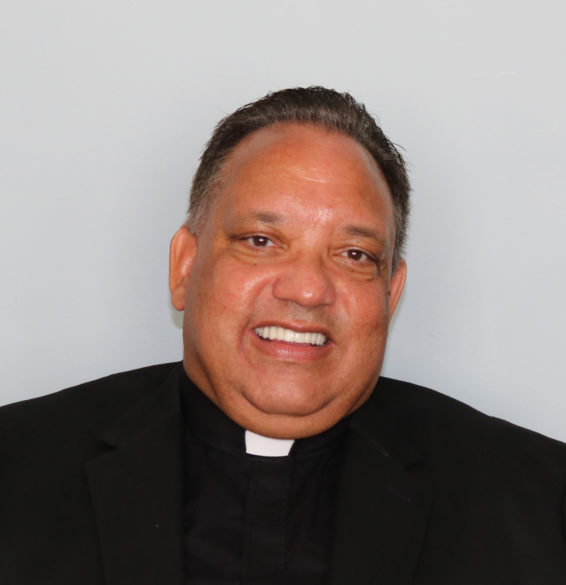
We’ve watched the excruciating video of an apprehended 46-year-old African American man by four Minneapolis police officers, hand-cuffed face down on the ground as one of the police officers relentlessly pressed his knee into his neck for eight minutes and forty-six seconds. Floyd in anguish cried out, “Please, I can’t breathe” to no avail and became unconscious and died of asphyxiation. Moments after George Floyd’s murder and continuing on today protests have erupted globally in cities large and small. The protesters have been multiracial and intergenerational indicating that they are united in their quest for justice and racial harmony. The demands for racial justice and equality, an end to racial violence, and police reform have reverberated incessantly.
No, George Floyd was not a saint, but he remains a symbol of something much more insidious: the sin of racism. This sin is an ever-present reminder that some people and institutions who have economic, social, cultural, political power and privilege deliberately or unwittingly subjugate and oppress those who do not enjoy equal power and privilege. Some social and economic advances notwithstanding, racism and discrimination continues to plaque the vast majority of people of color in our nation.
Systemic racism has been present in our country since 1619, the year that enslaved Africans were brought to the shores of what would eventually become the United States. Thus, for four-hundred years African Americans have fought for justice and equality: a fight that has never been fair nor equal. Four hundred years marked by the era of slavery, Reconstruction, “Jim Crow” segregation, the Civil Rights Movement, and the Black Lives Matter Movement. The struggle has been for the respect of their humanity and recognition as being created in the image and likeness of God — like all humanity. Dr. Martin Luther King, Jr. said, “Protest is the language of the unheard.” Protest is also the language of those who are tired of fighting and want the dominant culture to hear and to understand.
The voices crying out for the eradication of racism are not only being heard from the voices of the protesters on our city streets but from religious women and men, priests, laity, theologians, Bishops, and even from Pope Francis. Cardinal Blase Cupich of Chicago said, “People of color suffer discrimination and indignities not only from racist individuals, but from the very structures erected by our society that were meant to protect the vulnerable.” Pope Francis instructs us, “We cannot tolerate or turn a blind eye to racism and exclusion in any form and yet claim to defend the sacredness of every human life.” And still there is yet another voice of one who walked and worked among us and continues to call us to intercultural appreciation and racial reconciliation, Servant of God Sister Thea Bowman, FSPA. Here is her testimony: “I can be a bridge over troubled water. I can take you by the hand and take you with me into the black community. I can walk with you into your community, and if I walk with you into your community, I don’t enter as a stranger, I walk as your sister.”
We have a Mississippian who was a national witness to the possibility of racial healing and reconciliation. Sister Thea believed that we all must work to tear down the walls of racial division in our segregated and polarized society and church by making the effort to truly be in contact with one another: to get to know another’s story, their joys, sorrows, hopes and dreams. She was emphatic that the church as the Body of Christ must first confess her sin of racism, make amends and come to a place of healing and reconciliation. Then and only then can the church be a leader in racial healing globally. Sister Thea said: “May the Spirit within us and among us inspire us to keep on keeping on, in our homes and families, in our communities and in our church. May the Spirit inspire us, and may we share our spiritual and cultural gifts with the church and with the world. We’ve come this far by faith. Can’t turn around.”
Sister Thea, pray for us!
(Father Maurice J. Nutt, C.Ss.R. is a Redemptorist Missionary. Reverend Dr. Nutt’s areas of research and interests include pastoral theology, homiletics, African American culture, and the intersectionality of the church and the work of justice.)
First chance to receive Eucharist at Mass in months leaves some in tears
By Catholic News Service
PORTLAND, Maine – A parish priest in Bangor, Maine, said he saw many Massgoers “in tears” as they took holy Communion for the first time in close to three months at a publicly celebrated Mass June 7, Trinity Sunday, at St. Paul the Apostle Church.
Father Augustine Nellary, parochial vicar of the parish, said he was “extremely excited to have some of our parishioners back in the church and celebrate the Eucharist with them. I saw many of them in tears as they received the Eucharist.”
Across the country, Archbishop Jose H. Gomez of Los Angeles celebrated his first Mass with faithful present at the Cathedral of Our Lady of the Angels. Attendance was limited to 100 people, on a first-come, first-served basis, following the guidelines and regulations set by the County Health Department and the archdiocese.
In his homily, Archbishop Gomez said: “Today marks a beautiful new beginning for the family of God here in the Archdiocese of Los Angeles, as many of our churches are opening to celebrate the Eucharist for the first time in many weeks.”
On May 26, Archbishop Gomez told priests and parish staff churches in the archdiocese could begin to open to the public the first week of June if they implemented certain safety guidelines.
In recent weeks, U.S. dioceses have begun issuing plans for the gradual reopening of churches over several phases with the safety of congregants, priests, deacons and other parish staff foremost in the minds of Catholic officials – and with safety protocols in place, including required mask wearing and social distancing inside church, with seating in designated pews.
The gradual opening of churches or planned openings – with limits on congregation size – have for the most part come as cities and states announce a gradual reopening of a variety of what they deem as “nonessential” public and private entities, including churches, as the threat of COVID-19 has subsided – but not gone away entirely
Dioceses are still encouraging online giving to parishes, and Masses everywhere continue to be livestreamed.
In the statewide Diocese of Portland, Maine, the effort to reopen churches, even in a limited fashion, prompted creativity among clergy and parish staff. No more than 50 people could be in attendance, masks were mandatory, and temporary pew seating arrangements ensured social-distancing guidelines were followed. In addition, reservations were required to make sure capacity wasn’t exceeded.
But Catholics felt the regulations and protocols were small prices to pay for the opportunity to be together again.
“People were so very happy to be back at Mass. I told them how wonderful it was to have more people to pray with,” said Father John Skehan, pastor of St. Michael Parish in Augusta.
“We are grateful to God that we are able once again to celebrate and receive Eucharist together,” said Bishop Robert P. Deeley of Portland told Massgoers during his June 7 Mass at the Cathedral of the Immaculate Conception in Portland.
“How nice to see you this morning! Over these last three months, I have known that you are there, but it is nice to see some of you actually here with us this morning,” he added.
The bishop also described the work being completed at Maine churches after each Mass to keep those attending safe, including the sanitization of seats and pews, knobs, door handles, bathrooms, altars, musical equipment and other touched surfaces.
In Ontario, the provincial government lifted the blanket ban on services, allowing churches to resume public Masses and seat up to 30% of their capacity – the highest allowance in Canada – starting June 12.
Premier Doug Ford announced the loosening of restrictions June 8 as Ontario moved into stage 2 of its reopening plan. With Ontario churches reopening, Quebec is the only Canadian province yet to resume public Masses in some form.
But not all Catholic churches in Ontario reopened June 12. They will need to develop protocols to provide added hygiene, allow parishioners to maintain proper distancing and ensure that no more than 30% of the pews are occupied.
Bishop Ronald Fabbro of London, Ontario, said the news must be tempered with patience and health and safety remains paramount. “I ask for your patience. We have been working hard to prepare for the re-opening of churches, but we will need to make sure our communities can worship safely,” he said.
Robert Du Broy, communications director for the Archdiocese of Ottawa-Cornwall, Ontario, said some churches in the archdiocese are more prepared to open quickly than others. He said it will be left to individual churches to decide if they have the necessary number of volunteers and sanitary precautions and other safe-distancing measures in place.
Bishop Douglas Crosby of Hamilton, Ontario, said the reopening brings new challenges and the church will not look the same as it did pre-pandemic.
“We can expect instructions about social distancing, use of hand sanitizers and face masks, and how to receive holy Communion, among other things,” said Bishop Crosby. “We count on the goodwill of everybody to assure the safety of priests and congregation. Some of this will not be easy, but together we can do it.”
The bishops said their current guidelines for public celebrations of the Mass remain in effect for now: sign up to attend, physical distancing, contact tracing, hand sanitizing, no singing, and requiring masks for volunteers and all those who wish to receive Communion.
“We are grateful to all those who have worked so hard to make the necessary preparations, and to our parishioners for the patience and the responsibility toward others that they have demonstrated as they have returned to Mass,” Alberta’s bishops said June 9.
Back in Maine, Julie Ann Smyth, a member of Good Shepherd Parish in Biddeford, was one of those brought to tears by being able to attend Mass in church once again.
“As soon as the opening song started playing, I teared up. It was overwhelming to think about the past two months,” she said. “To return to the pew and to be with others who share your love of your faith, it was just so special.”
Contributing to this story were the staff of Angelus in Los Angeles, Mickey Conlon at The Catholic Register in Toronto and Andrew Ehrkamp of Grandin Media.
Unidos en oración y enfoque en Misa Crismal
La Misa Crismal confirma mejor que la iglesia,
el Cuerpo de Cristo, es el sacramento de salvación para el mundo cuando la unción del Espíritu Santo capacita a todos los bautizados para vivir su
vocación como colaboradores en la viña del Señor.
Por Obispo Joseph Kopacz
Al comienzo de esta semana, se celebró la Misa Crismal, en la Catedral de San Pedro Apóstol, aproximadamente dos meses después de la Semana Santa.
La mayoría de nuestras más preciadas tradiciones han sido alteradas radicalmente, pospuestas o canceladas a raíz de la pandemia mundial. En lugar de una Catedral llena de personas, representando a todos los rincones de la Diócesis de Jackson, solo asistieron entre 50 y 60 sacerdotes, según lo permiten las limitaciones del distanciamiento social.
Fue una reunión menos festiva, pero la realidad de quiénes somos nunca puede verse disminuida porque Jesucristo es el mismo ayer, hoy y siempre. El Prefacio de la Misa Crismal proclama claramente nuestra identidad, establecida a través de la fe, el bautismo y el camino de aquellos llamados al Orden Sagrado.
“Porque por la unción del Espíritu Santo hiciste a tu Hijo unigénito como Sumo Sacerdote del nuevo y eterno pacto, y por tu maravilloso diseño te complació decretar que su único Sacerdocio debía continuar en la iglesia. Porque Cristo no solo adorna con un sacerdocio real a las personas que ha hecho suyas, sino con la amabilidad de un hermano, también elige a los hombres para que participen en su ministerio sagrado mediante la imposición de manos. Deben renovar en su nombre el sacrificio de la redención humana, poner delante de sus hijos el banquete pascual, guiar a su pueblo santo en la caridad, nutrirlos con la palabra y fortalecerlos con los sacramentos. Al renunciar a sus vidas por usted y por la salvación de sus hermanos y hermanas, se esfuerzan por ser conformados a la imagen del mismo Cristo y ofrecerle un testimonio constante de fe y amor.”
La primera carta de Pedro en el Nuevo Testamento declara esta elevada imagen para aquellos que son miembros del Cuerpo de Cristo. “Pero ustedes son una familia escogida, un sacerdocio al servicio del rey, una nación santa, un pueblo adquirido por Dios. Y esto es así para que anuncien las obras maravillosas de Dios, el cual los llamó a salir de la oscuridad para entrar en su luz maravillosa.” (1 Pedro 2:9)
Junto con la renovación de los votos sacerdotales y la oración de aprobación de todos los presentes, físicamente y en espíritu, la bendición del Aceite de los Catecúmenos, el Aceite de los Enfermos y la consagración del Aceite del Crisma ocurre en el santuario. Los sacramentos del Bautismo, la Confirmación, las Órdenes sagradas y la Unción de los enfermos capacitan a los fieles cristianos para abrazar el estilo de vida que comenzó con Jesús el Cristo, el “Ungido”, el que es el Camino, Verdad y Vida.
La Misa Crismal confirma que la iglesia, el Cuerpo de Cristo, es el sacramento de salvación para el mundo cuando la unción del Espíritu Santo capacita a todos los bautizados para vivir su vocación como colaboradores en la viña del Señor.
En los últimos tres meses, ha existido una considerable colaboración y comunicación para tomar las mejores decisiones con respecto a las reuniones públicas, en nombre del bien común. Hubo llamadas semanales, en conferencia, y conversaciones diarias que pusieron en acción la unidad que es celebrada en la Misa Crismal.
Del mismo modo, el principio de subsidiariedad dio forma a lo que debería o podría hacerse a nivel local y estatal para la reapertura progresiva y por extensión a lo largo de las parroquias de nuestra diócesis. La subsidiariedad se manifestó cuando todos los asistentes a la Misa Crismal regresaron a sus hogares y ministerios con los Aceites Sagrados en la mano, para servir al Pueblo de Dios por otro año, esta vez en circunstancias particulares.
Aunque nuestra Misa Crismal fue restringida este año por un tsunami viral de una vez en un siglo, vi una Catedral llena a tope de una nube de testigos de toda la Diócesis, con quienes estábamos unidos en oración y propósito.
Agradezco a todos los líderes de nuestra diócesis, ordenados y laicos, que han redoblado sus esfuerzos en estos tiempos preocupantes para servir al Señor de maneras inesperadas.
Les pido sus oraciones por nuestros sacerdotes, jóvenes y mayores, que, como ustedes, sienten el dolor de la separación de las personas que aman.
Finalmente, compartan mi alegría con la próxima celebración de las Sagradas Órdenes el próximo 27 de junio, cuando ungiré al Diácono César Sánchez y al Diácono Andrew Nguyen con el Aceite del Crisma, para el comienzo de su respectivo sacerdocio en la Diócesis de Jackson.
Prayer is a ‘fight’ with God
By Junno Arocho Esteves
VATICAN CITY (CNS) – True prayer is a “fight” with God in which those who think they are strong are humbled and faced with the reality of their own mortal condition, Pope Francis said.
The story of Jacob wrestling with God throughout the night is a reminder that although prayer reveals “that we are only poor men and women,” God also has a “blessing reserved for those who have let themselves be changed by him,” the pope said June 10 during his weekly general audience.
“This is a beautiful invitation to let ourselves be changed by God. He knows how to do it because he knows each of us. ‘Lord, you know me,’ each one of us can say. ‘Lord, you know me. Change me,’” the pope said.
In the audience, livestreamed from the library of the Apostolic Palace at the Vatican, the pope continued his series of talks on prayer. And before concluding the audience, he reminded the faithful of the June 12 observance of the World Day Against Child Labor.
Calling child labor a “phenomenon that deprives boys and girls of their childhood,” the pope said that the COVID-19 pandemic has forced children and young people in many countries to work in “jobs that are inappropriate for their age to help their families in conditions of extreme poverty.”
He also warned that “in many cases, these are forms of slavery and imprisonment, resulting in physical and psychological suffering.”
The pope’s concern for child labor comes nearly a week after the death in Pakistan of Zhora Shah, an 8-year-old child maid who allegedly was beaten to death by her employers after accidentally releasing their prized parrots. The case has sparked outrage in Pakistan and around the world.
“Children are the future of the human family,” Pope Francis said. “It is up to all of us to foster their growth, health and serenity!”
In his main talk, the pope reflected on the story of Jacob, an “unscrupulous man” who despite the odds, “seems to succeed in every feat in his life.”
“Jacob – we would say in today’s modern language – is a ‘self-made man.’ With his ingenuity, he is able to conquer everything he wants. But he is missing something: he lacks the living relationship with his own roots,” the pope said.
It is on a return trip to see his brother Esau – whom he defrauded for an inheritance – that Jacob encounters the stranger who fights with him. Citing the Catechism of the Catholic Church, the pope said that this struggle is “the symbol of prayer as a battle of faith and as the triumph of perseverance.”
Overcome by a strike to the hip, the stranger – whom Jacob later realized is God – blesses him and gives him the name “Israel.” The pope said that Jacob ultimately enters the promised land with a limp, but also “with a new heart.”
“Before he was a confident man, he trusted in his own cunning,” he said. “He was a man impervious to grace, resistant to mercy. But God saved what was lost.”
“We all have an appointment with God in the night,” Pope Francis said. “He will surprise us when we do not expect it, when we find ourselves truly alone.”
But, the pope said, “we need not fear because in that moment, God will give us a new name that contains the meaning of our whole life.”
Follow Arocho on Twitter: @arochoju
The early days of Holy Week
SPIRIT AND TRUTH
By Father Aaron Williams
In my previous column, I discussed the development of the liturgy of Palm Sunday. In this edition, I want to address Masses which belong to the ‘early days’ of Holy Week: namely, Monday, Tuesday and Wednesday.
The Mass given for the Monday of Holy Week has been surprisingly consistent throughout the centuries, more so perhaps than any other Mass during the week. The Gospel passage is taken from the twelfth chapter of St. John’s gospel and chronologically speaking occurs the day before Palm Sunday, making it interesting to be placed the day after in the Lectionary. But, there are two reasons for the placement of this passage: one, because it makes mention of the rising of Lazarus within the context of the Passover (thus, foreshadowing the rising of Christ), and second, because of St. John’s aside that Judas was a thief and would take money from the apostle’s communal purse.
Apart from the Gospel, there is no proper rite associated with this day. Before the reform of the Holy Week liturgies promulgated by Pope Pius XII in 1955, special petitions were offered on this day against the church’s persecutors and for the Pope. These were suppressed in 1955, and with the exception of the change of the order of the Mass, the Mass given in the Missal of 1962 is virtually the same as the Mass in the Missal of Pope St. Paul VI.
The Masses of Tuesday and Wednesday are where we see real change. Prior to the reforms which followed the Second Vatican Council, the Passion according to St. Mark was read in full in the Mass of Tuesday, and that of St. Luke was read at the Mass of Wednesday; St. Matthew’s had been read on Palm Sunday. In the reformed Mass, the gospels of Palm Sunday are read on a three-year cycle so each year during Holy Week the faithful only hear two readings of the Passion: one from either Matthew, Mark, or Luke and then St. John’s version on Good Friday. In the older form of the Mass, all four Passion accounts were read during the course of the week.
There was a slight alteration in the length of the Passion readings from before 1955 and after. In the liturgies before 1955, the synoptic Passion readings included the account of the Last Supper. This section was removed after 1955 and the readings begin in the Garden of Gethsemane.
The modern Roman liturgy introduces two new Gospel readings for Tuesday and Wednesday, but with a sort of traditional flair. The reading given for Tuesday is Our Lord’s prediction of the betrayal of Judas at the Last Supper as given in St. John’s Gospel. The placement here is appropriate since the next day, Wednesday, is traditionally known as “Spy Wednesday” – when Judas met with the chief priests to arrange the manner in which he would betray Jesus. Naturally, the Gospel passage in the modern liturgy which is read on Wednesday is this the account of this meeting between Judas and the Jewish authorities as given in St. Matthew’s Gospel.
Thus, while the arrangement of the readings in the older form of the Mass were designed to bring the faithful’s attention to the events of the Passion itself, the readings of the newer form intentionally lead the faithful chronologically through the events of Holy Week in the order they played out.
One final note since I will not have space to provide a full column on this topic. In the early Medieval liturgical rites in use prior to the Council of Trent, these three days served as a final preparation for the Penitents to be given absolution on Holy Thursday morning. Formerly, grave public sinners brought themselves to the door of the Cathedral on Ash Wednesday when they were ceremonially ‘cast out’ of the church and given sackcloth to wear in penitence for all of Lent. In these last days, their penitence often took on a more physical form and they would beg outside the door of the Cathedral until the morning of Holy Thursday when the Bishop would prepare to meet them inside at the altar.
The deacon would go outside into the square and three times tell the penitents to approach the church. Three times the penitents would step forward and prostrate themselves. Once this was completed, the deacon took them by the hand and led them straight through the church and up to the altar where the Bishop would remove their sackcloth and grant them sacramental absolution. This would allow them to rejoin the faithful for the Mass of Holy Thursday night where they could once again partake in Holy Communion.
In my next column I will discuss a the traditional prayer service of Tenebræ, which is regaining popularity today in many parishes, as well as ways this service is even included, in an altered form, in the modern Liturgy of the Hours.
(Father Aaron Williams is the administrator at St. Joseph Parish in Greenville)
Featured photo . . .
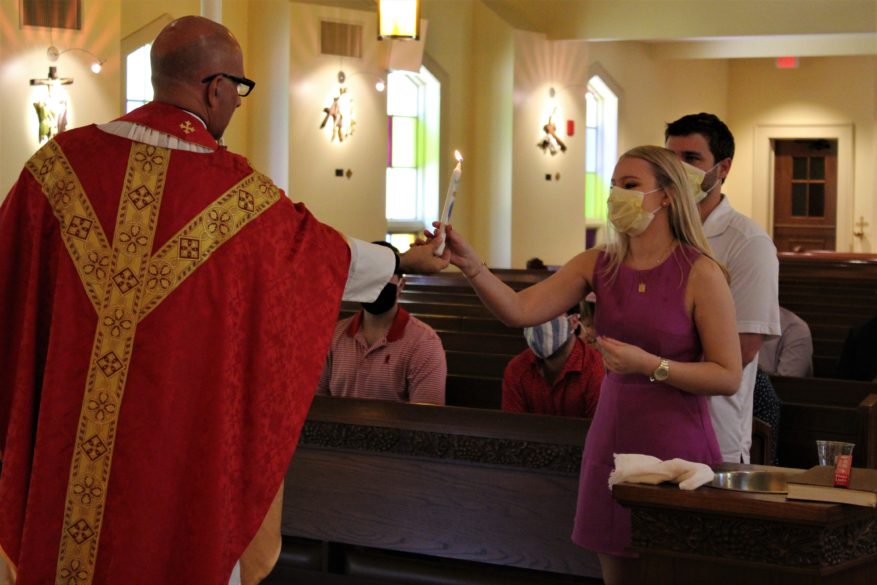
Calendar of events
SAVE THE DATE
JACKSON St. Richard School, Save the Date Friday, Feb. 12, 2021, Krewe de Cardinal. Details: church office (662) 256-8392.
NATIONAL Virtual 2020 Catholic Immigrant Integration Initiative, Oct. 1-2. The CIII seeks to understand, expand and strengthen the work of Catholic institutions with immigrant communities. Registration will open soon. To receive updates about registration, please fill out this form: https://forms.gle/4gX2XS3enWoP9vAp9. Details: For details about the virtual conference visit https://cmsny.org/event/2020-catholic-immigrant-integration-initiative/
YOUTH/VACATION BIBLE SCHOOL
CLARKSDALE St. Elizabeth, Virtual VBS, Monday July 6-10. You will receive a video playlist for each day of the week. Details: Call 662-624-4239 to reserve a spot.
NATCHEZ St. Mary Basilica, CYO Virtual Summer Camp, Tuesday June 23-25. Ten service hours will be awarded to those who attend all three days. There will be small group discussions, speakers, games and more. Details: Call Carrie Lambert, youth director at 601-445-5616.
PEARL St. Jude, Drive-in VBS: Crayons – The Colorful Life of King David. Families will park their cars and enjoy a Bible story about King David, a snack and a story of a saint. Monday evenings 6:30-7 p.m. on June 15, 22, 29 and July 6, 13, 20, 27. For children in K-6th grade. Registration is required for the days you plan to attend. Details: Register at https://signup.com/go/thDEvnX.

